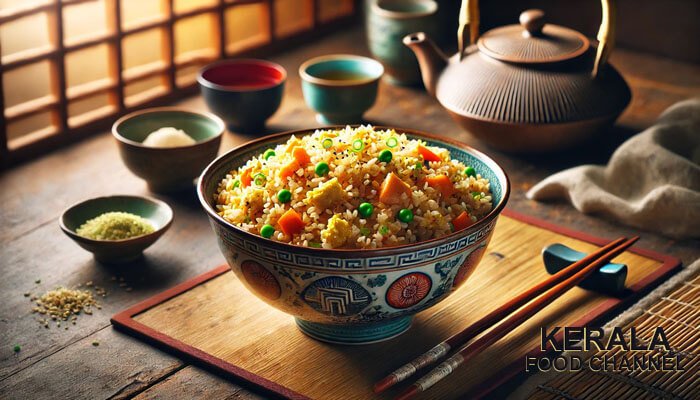Japanese Fried Rice Recipe: How to make Japanese Fried Rice?
Japanese fried rice, known as Chahan in Japan, is a flavorful and easy-to-make dish that can be prepared in under 30 minutes. It is a staple in Japanese homes and restaurants, offering a unique umami taste and light yet satisfying texture. Unlike Chinese-style fried rice, Japanese fried rice often incorporates soy sauce, dashi, and mirin for a slightly sweet and deep umami flavor. This dish is perfect for a quick lunch or dinner and can be customized with various ingredients to suit your taste.
Ingredients
Base Ingredients:
- 2 cups cooked Japanese short-grain rice (preferably day-old)
- 2 tablespoons vegetable oil or sesame oil
- 2 eggs, lightly beaten
- 1/2 cup diced onion
- 1/2 cup chopped green onions
- 1/2 cup diced carrots
- 1/2 cup frozen peas (optional)
- 2 cloves garlic, minced
- 1/2 teaspoon grated ginger
Protein Options: (Choose one or mix!)
- 1/2 cup diced chicken (boneless, skinless)
- 1/2 cup cooked shrimp
- 1/2 cup cubed firm tofu (for a vegetarian option)
- 1/2 cup diced ham or bacon
Seasoning and Sauces:
- 2 tablespoons soy sauce (low-sodium preferred)
- 1 tablespoon mirin (sweet rice wine)
- 1 tablespoon sake (optional, adds depth)
- 1 teaspoon dashi powder (optional but enhances umami)
- 1/2 teaspoon salt (adjust to taste)
- 1/2 teaspoon white pepper
- 1 teaspoon butter (for final touch)
Instructions
Step 1: Prepare Your Ingredients
Before you start cooking, ensure all ingredients are chopped and ready. If using leftover rice, break up any clumps for even frying.
Step 2: Cook the Eggs
- Heat 1 tablespoon of vegetable oil in a wok or large skillet over medium-high heat.
- Pour in the beaten eggs and scramble them quickly until just cooked.
- Remove from the pan and set aside.
Step 3: Sauté Vegetables and Protein
- Add another tablespoon of oil to the pan.
- Sauté onions, carrots, garlic, and ginger for 2-3 minutes until fragrant.
- Add the protein of your choice and cook until fully cooked (about 4-5 minutes for chicken/shrimp, 2 minutes for ham/tofu).
Step 4: Stir-Fry the Rice
- Add the cooked rice to the pan and stir-fry for 2-3 minutes.
- Pour in soy sauce, mirin, sake, dashi, salt, and white pepper. Mix well to coat the rice evenly.
Step 5: Add the Eggs and Finish
- Return the scrambled eggs to the pan and mix well.
- Stir in the green onions and peas (if using).
- Add a teaspoon of butter and mix for a rich flavor boost.
- Cook for another 1-2 minutes, then turn off the heat.
Step 6: Serve and Enjoy!
- Transfer the fried rice to plates or bowls.
- Garnish with extra green onions or sesame seeds if desired.
- Serve hot with a side of miso soup or pickled ginger.
Serving Suggestions
Japanese fried rice pairs well with:
- Miso soup – A warm, umami-rich soup
- Gyoza (Japanese dumplings) – Crispy and juicy dumplings
- Pickled ginger or daikon – Adds a refreshing contrast
- Green tea or sake – A classic Japanese beverage choice
Nutritional Information (Per Serving)
(Approximate values, varies by ingredients used)
- Calories: 350-400 kcal
- Protein: 15-20g
- Carbohydrates: 45-50g
- Fats: 10-15g
- Fiber: 3-5g
- Sodium: 600-800mg (adjust with low-sodium soy sauce if needed)
5 Frequently Asked Questions (FAQs)
1. Can I use freshly cooked rice instead of day-old rice?
Yes, but day-old rice is preferred because it is firmer and less sticky, preventing mushy fried rice. If using fresh rice, spread it on a tray and let it cool before frying.
2. What can I substitute for mirin?
You can use a mixture of sugar and rice vinegar (1 tablespoon vinegar + 1 teaspoon sugar per tablespoon of mirin).
3. Can I make this recipe vegan?
Yes! Simply use tofu or mushrooms instead of meat, and replace eggs with scrambled soft tofu.
4. What’s the difference between Japanese fried rice and Chinese fried rice?
Japanese fried rice uses short-grain rice, which is slightly sticky, and has seasonings like soy sauce, mirin, and dashi, giving it a subtly sweet and umami-rich flavor. Chinese fried rice typically uses long-grain rice and a mix of soy sauce and oyster sauce.
5. Can I freeze Japanese fried rice?
Yes! Store it in an airtight container and freeze for up to 3 months. Reheat in a pan with a little oil or in the microwave.
Not Advisable For:
While this dish is generally healthy, it may not be advisable for individuals with high sodium restrictions (due to soy sauce) or those allergic to soy, gluten (unless using gluten-free soy sauce), or seafood (if shrimp is included). Adjust accordingly to dietary needs.
Conclusion
Japanese fried rice is a quick, flavorful, and versatile dish that can be made with simple ingredients. Whether you prefer a meaty or vegetarian version, this recipe provides a delicious way to enjoy a taste of Japan in your own kitchen. Try it today and elevate your home-cooked meals!






